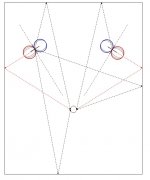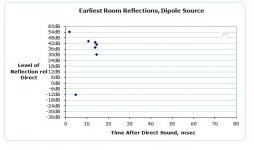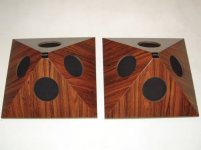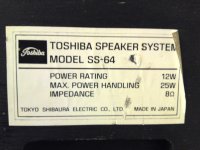Exlusive = Only, Only advantage of FCUFS is that it is cheap alternative to completely forward firing array of speakers.
Really ought just stop this thread right here.
You'll never get past this statement.
???
You really ought just to leave this thread right now, because - why bother?
besides You clearly misunderstood my statement which in fact is a statement made in the very first post of this thread
Last edited:
then what to do? Wide range ribbons or electrostats with separate subs? Line arrays of small drivers?
Question what is necessary for us to reduce or enhance for FCUFS to be maximized. I am a fan of planar magnetic transducers and AMT's due to their speed / low distortion. Proper wavefront generation and control of said wavefront would be imperative. Which brings wave guides/ horns into the picture. Have not seen a single FCUFS speaker with them. I never liked horns per se. They do have better acoustic impedance matching, but sounded so wrong. Tho some far better than others. Reading jmmlc's work, Lynn Olson's thread that brought them to my attention and the research soongc has done (I'm leaving several others out, alot of people get credit here
For example I'm not against direct radiator speakers, but unlike so many, am not so willing to throw in the towel just because somebody else just thinks they know it's wrong, can't be done. Have been burned so many times in the past by people acting as if what they are saying is fact, is not, that my NOW additude is bite me! (that might be old age kicking in, NAW!
Was messing around with my son's stereo today (bedroom system) Marantz receiver, couple of 4" fullrange speakers connected to that and an old 6.5" Monsoon subwoofer (PM9's). We were jammin out to some tunes having snacks. When I noticed a peculiar effect I'd fogot about. When positioned within the typical stereo but sitting sideways. Left (or right) ear directly hearing both speakers equally well, moving in and out ie side to side could shift the sound from a front to back effect, which is normal, to a point where I could hear the sound directly in front of me but the left (behind me) remained the same. It is range limited below say below ~3k so no top end (head effect) but as solid as can be, and a fairly wide area where this effect could be heard. When I lowered the treble a scoche I could only hear the left channel speaker behind me, but not the right channel speaker. Still had the front to back stereo effect.
This brings me think about the other thread "Uniform Directivity - How important is it" and talk of using circumaural microphone setup for these measurements. I tend to think of hearing similar to seeing. In the center max resolution, slightly beyond but not to the outer edge full color, outer edge of sight in black and white. If this combination of Chroma and Luminance is akin to our Frequency and Phase then we must somehow measure polar phase patterns of our ear/head. I'm sure we are all to one degree or another fairly similar. Messing with this some eons ago do remember using this same effect with two sets of speakers direct firing to lift an image vertically, but am a bit foggy atm. Hmmm more things to remember and ponder...
I've spent a fair amount of time auditioning the AH425 and other LeCleac'h Azurahorns. Subjectively, not much happens off-axis ... there's no sudden change, the sound just loses a bit of focus ... it's quite not as sharp and crisp. But it's a fairly small change compared to most other horns I've auditioned, which can sound very different as you walk around the room (for example, when you walk out of the beam of a conical horn).
Subjectively, it sounded best slightly off-axis, with about half of the throat of the compression driver visible from the listening position. By measurement, there's not much change over a 10-degree span, and no on-axis suckout or other weirdness to deal with. As get further off-axis, it just rolls off earlier, with no sudden change, and this continues even when you get way, way off-axis, like 90 degrees, or even behind the loudspeaker. It basically acts like a fairly big dome tweeter in terms of directivity, not like a horn at all.
I usually "voice" speakers using pink-noise, aiming for natural sound at all possible listening positions, and going to some trouble to avoid obvious whistling phasey sounds when well off-axis. This is where conicals and exponentials can be troublesome: if EQ'ed for good behavior over a frontal 45-degree sweep, they can get pretty weird at 60, 90, and 120 degrees off-axis, with very strange impulse and frequency response. The LeCleac'h T=0.707 just rolls off, with no deep nulls or peaks when far off-axis.
Lynn does a phenomenal job of describing what I believe happens when proper wavefront propagation occurs. Full post here.
Exlusive = Only, Only advantage of FCUFS is that it is cheap alternative to completely forward firing array of speakers.
Really ought just stop this thread right here.
You'll never get past this statement.
I said the same thing about 20 pages back. I see no advantage to floor coupled speakers, but some disadvantages. If you like the effect, good. If you like accuracy, keep stepping.
Apparently you have neither built speakers nor truely experimented with acoustics outside of what was written in a book for studios, and more specifically doing multitrack movies.
If you were, hmmm, say Alan Parson's, certainly would listen, but what your experience seems to be is quoting others work, multitrack movie soundtracks, with commercially built speakers and studios. I'm sure your peers would have frowned if you had deviated from the norm within exceptable limits. Been there, Seen that before. Definition of exceptable limits is as long as it's what the other guy either approves of or is drooling over to do or have. Been caught between the disagreements on design between consultant's. (and I thought women could get their pant*es up in a bind. WoW my apologies lady's
BTW We're talking about music reproduction in the stereo 2ch format ONLY. Be it FCUFS or not.
Perhaps your own thread discussing how virtually every highly respected member here cannot possibly appreciate the full glory when not listening to music in 5.1./7.1? Or maybe like none of us know what it should sound like because we aren't you the mixmaster and how you intended it to sound on your commercially built multichannel system? Thank heavens we're a little more civilized than the Jerry Springer Show for that to happen. Or should we just quote?
If you were, hmmm, say Alan Parson's, certainly would listen, but what your experience seems to be is quoting others work, multitrack movie soundtracks, with commercially built speakers and studios. I'm sure your peers would have frowned if you had deviated from the norm within exceptable limits. Been there, Seen that before. Definition of exceptable limits is as long as it's what the other guy either approves of or is drooling over to do or have. Been caught between the disagreements on design between consultant's. (and I thought women could get their pant*es up in a bind. WoW my apologies lady's
BTW We're talking about music reproduction in the stereo 2ch format ONLY. Be it FCUFS or not.
Perhaps your own thread discussing how virtually every highly respected member here cannot possibly appreciate the full glory when not listening to music in 5.1./7.1? Or maybe like none of us know what it should sound like because we aren't you the mixmaster and how you intended it to sound on your commercially built multichannel system? Thank heavens we're a little more civilized than the Jerry Springer Show for that to happen. Or should we just quote?
Exlusive = Only, Only advantage of FCUFS is that it is cheap alternative to completely forward firing array of speakers.
So you're saying that if I lay down a pair of 10k towers it's a cheap alternative?

If I find those same speakers in the store laying on their backs they are alot cheaper?

What are you defining as "cheap" exactly?
Really ought just stop this thread right here.
should this read.. Really ought to just stop reading this thread right here. or Really ought to just stop bothering with this thread right here. Or Really ought to just stop responding to this thread right here... Just trying to decode
You'll never get past this statement.
Now dagnabit, look what you've gone 'n done! Ya burn'n up my Capt'n Crunch decoder ring with that infinite loop crap.
I said the same thing about 20 pages back. I see no advantage to floor coupled speakers, but some disadvantages. If you like the effect, good. If you like accuracy, keep stepping.
Just for the record, I've said something similar even years back (this thread is running since 2008). Guess one can't argue against beliefs.
There is an echo in here. Perhaps it's bouncing off the ceiling; but it must be bouncing off the walls too, because it just won't die out.
When I cup my ears and listen closely I can just make it out: You'll never get past this statement.
but what's the point?
Note: Thread title changed.
In this positioning they happen to be quite similar to the late Stig Carlsson designs (carlssonplanet.com, but the Carlssons are two-way and much more complicated because of that) but were not inspired by them.
I didn’t know the Carlssons when I was building these and my first and main aim was to eliminate the detrimental effect of early floor and ceiling reflections without resorting to unavailable true linesource (like Beveridge)
what's the problem?
Direct sound vs. "no direct sound"
another interesting "no direct sound" placement method: Stereo Unlimited tweak
actually it resembles the two channel SSS more than a FCUFS system (BTW - FCUFS is NOT a "no direct sound" method)
Attachments
It's also not a Bose thing, or IMHO something that can be done with a typical 2 way sitting on the floor on it's back.
Graaf,
The off axis response becomes very critical when doing this. If this direct far off axis response is compensated for everything improves.
Have you tried a small two way direct radiating at listening heigth and then added upfiring drivers with either a larger full range (top most octaves not as important) or midbasses? Would want to reduce output above say 4-5k (perhaps a tad lower in the 3k range), so something like a 8" or larger full range or midbass in the 6.5" size or larger that will do it clean with a minimal breakup peak. Using seperate amps so you have independent control over these. If you can please do
Think MTM-MM or TM-M, but the .5 is wired as another mid eg not just for BSC, just off axis up firing from the floor. Also try this with same floor firing speaker from just behind the direct radiating speaker up firing. Takes a bit of tweaking the responses for everything to meld together properly, typically reducing the direct level and/or EQ of both.
Graaf,
The off axis response becomes very critical when doing this. If this direct far off axis response is compensated for everything improves.
Have you tried a small two way direct radiating at listening heigth and then added upfiring drivers with either a larger full range (top most octaves not as important) or midbasses? Would want to reduce output above say 4-5k (perhaps a tad lower in the 3k range), so something like a 8" or larger full range or midbass in the 6.5" size or larger that will do it clean with a minimal breakup peak. Using seperate amps so you have independent control over these. If you can please do
Think MTM-MM or TM-M, but the .5 is wired as another mid eg not just for BSC, just off axis up firing from the floor. Also try this with same floor firing speaker from just behind the direct radiating speaker up firing. Takes a bit of tweaking the responses for everything to meld together properly, typically reducing the direct level and/or EQ of both.
Last edited:
another interesting "no direct sound" placement method: Stereo Unlimited tweak
I think it results hole in the middle. Side wall reflections arrive in very wide angle, AND there is no strong center sound.
Looks like I guessed right (from the link):
At first I didn't like it, there seemed to be an empty space between
- Elias
I think it results hole in the middle. Side wall reflections arrive in very wide angle, AND there is no strong center sound.
Looks like I guessed right (from the link):
- Elias
or rather You didn't
first, because what You quoted described the sound of the setup with "the speakers facing each other, and facing the side walls", and only after then the quoted user toed the speakers in as in the scheme I posted
second, because it was not a hole really
third because it might just as well be a matter of an accumulated bias as the user reports that an ubiased listener immediately liked it: "My wife immediately liked it"
I have just realized that indeed the same principle of making use of the dipole null is applied in the Gradient Helsinki 1.5 - the listener sits in the null of the woofer dipole.
This configuration - along with the cardioid midbass unit and waveguided tweeter - secures that no first order floor reflection reaches the listener across the whole reproduced frequency range.
However, as an alternative method of achieving this same effect the dipole null method suffers a serious disadvantage vs FCUFS - the bass level is usually subjectively insufficient and it requires an active line level compensation.
This configuration - along with the cardioid midbass unit and waveguided tweeter - secures that no first order floor reflection reaches the listener across the whole reproduced frequency range.
However, as an alternative method of achieving this same effect the dipole null method suffers a serious disadvantage vs FCUFS - the bass level is usually subjectively insufficient and it requires an active line level compensation.
That's what I experienced when rotating my dipoles 90°. I calculated the early reflections with James Heddles spreadsheet at http://www.linkwitzlab.com/LX521/Dipole First Room Reflections SL rev3-a.xlsI think it results hole in the middle. Side wall reflections arrive in very wide angle, AND there is no strong center sound.
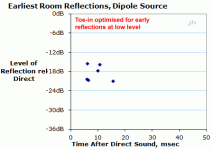
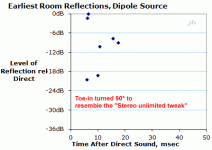
Left picture is what I have at home - and like
That's what I experienced when rotating my dipoles 90°. I calculated the early reflections with James Heddles spreadsheet at http://www.linkwitzlab.com/LX521/Dipole First Room Reflections SL rev3-a.xls
View attachment 357016 View attachment 357017
Left picture is what I have at home - and like. Right is the Stereo Unlimited proposal
.
But this NOT the SU method modified by toeing the dipole null (90°) axis towards the listener? Because in such a case there would be NO DIRECT SOUND.
Can You try it please?
And can You post a scheme of Your room and setup's layout?
I have just realized that indeed the same principle of making use of the dipole null is applied in the Gradient Helsinki 1.5 - the listener sits in the null of the woofer dipole.
I think the reason for sideways bass dipole is rather more practical, because it allows placing the speaker against the front wall which is very important in small European size living rooms. Very seldomly one can leavy an empty space of one meter or more behind the speakers as would be required by conventional bass dipole, and Gradient has solved the issue by rotating the bass dipole.
- Elias
- Home
- Loudspeakers
- Multi-Way
- The Advantages of Floor Coupled Up-Firing Speakers
